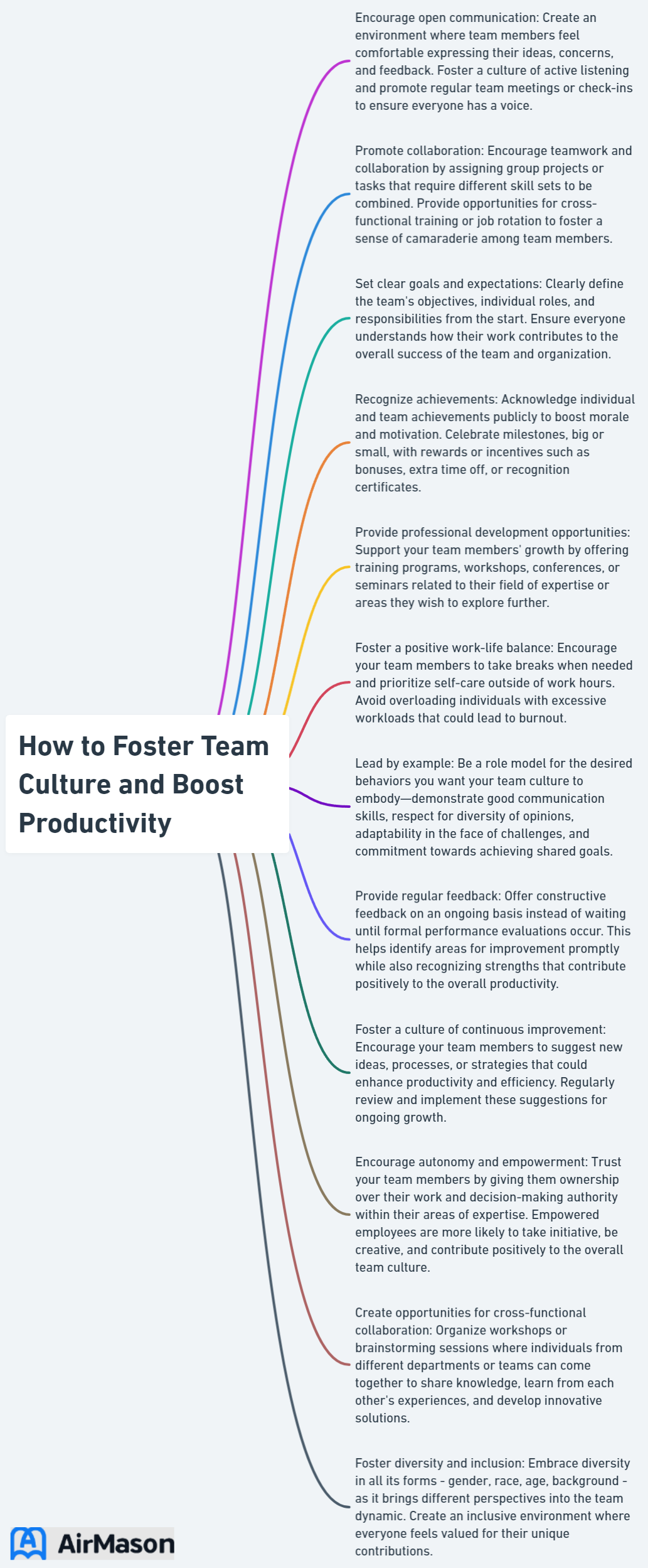
In today’s fast-paced business world, fostering a strong team culture is no longer just a nice-to-have but an essential ingredient for success. A thriving foster team culture can unlock the true potential of your employees, boost productivity, and ultimately, drive your organization’s growth. Are you ready to unlock the secret to creating a powerful team culture that can transform your workplace? Let’s dive in!
Key Takeaways
- Foster team culture and boost productivity by creating a positive environment, encouraging open communication, celebrating successes and developing strong leadership skills.
- Nurture personal growth through skill-building activities while offering flexible options to empower employees.
- Promote diversity & inclusion with continuous feedback loops for learning & growth opportunities.
The Significance of Team Culture
A strong company culture can have a profound impact on employee satisfaction, retention, and ultimately, business success. A well-crafted team culture can:
- Enhance individual and team morale
- Increase workplace engagement
- Improve job satisfaction
- Attract top candidates
- Elevate productivity
- Lower turnover
- Bolster employee engagement
So, how can we create a healthy corporate culture? The first step is to lay out the company’s values and core values that everyone can rally around. Prioritizing respect in the workplace ensures that every individual, regardless of their status within the company, feels valued and heard. Providing employees with access to the support and resources they need, such as HR representatives with flexible schedules and an anonymous sexual harassment hotline, can also help build a positive work environment.
Investing in a healthy corporate culture pays off significantly, both for employees and customers. A positive work culture encourages collaboration, innovation, and productivity, ultimately improving the organization’s overall performance and profitability.

Building a Resilient Team
Building a resilient team necessitates fostering cooperation and encouraging open, honest communication to ensure alignment of goals with the company’s values. A chief human resources officer can promote cooperation and communication by implementing an open-door policy, allowing employees to share innovative ideas and provide constructive suggestions.
The provision of support and resources stimulates team members to take ownership and initiative, while also freeing leaders to concentrate on more strategic tasks. By implementing a system that reward team members for their valuable contributions, leaders can create an environment where employees feel comfortable expressing their ideas and opinions without fear of being ignored or criticized.
Encouraging Open Communication

Open communication is the cornerstone of any successful team. Effective communication fosters connection, agreement, and clarity within a team, with positive impacts on the physical and mental health of team members. Fostering transparency in team culture can be achieved by launching an internal newsletter to keep the team updated on important information and hosting monthly town hall meetings to provide context for company-wide announcements.
Using nonverbal communication, such as body language and tone of voice, can help convey your message more clearly and effectively. Choosing the right tools that encourage communication and remove formality is vital for remote teams. Select remote work solutions that reflect your team’s culture and make it as easy as possible for your team to stay informed.
Nurturing Personal and Professional Growth
The promotion of personal and professional growth, as well as a healthy personal life, is fundamental to a thriving team culture. Skill-building and professional development not only foster better employee relationships but also enhance collaboration and camaraderie, creating a more positive work experience. Developing positive relationships between colleagues can lead to increased job satisfaction, improved productivity, and reduced turnover.
Coaching and mentoring are powerful tools for team leaders to help team members improve their performance and achieve their goals. Team leaders who provide guidance, feedback, and support, and share knowledge, experience, and insights, cultivate a culture of collaboration and trust.
Empowering Employees through Flexibility
Flexible schedules are highly valued by job seekers, with almost half of them stating that “flexibility and autonomy” are the most important factors in an employer. Offering options such as remote work, flexible hours, and adaptable job roles can help employees manage their personal responsibilities outside of work, demonstrating trust and respect for employees.
However, let’s not forget that remote work can potentially lead to feelings of loneliness and challenges in maintaining a work-life balance. Being accommodating and approachable as a leader can help employees feel supported and respected in such situations.
Understanding an Organization’s Culture
An organization’s culture encompasses the shared values, beliefs, and behaviors that shape its identity and guide its members. It serves as the invisible framework that influences how employees interact, make decisions, and ultimately contribute to the company’s success. Understanding an organization’s culture is pivotal for effective leadership and seamless integration of new members into the team. It permeates every facet of the workplace, from the way tasks are accomplished to the way conflicts are resolved. This culture is not static; rather, it evolves over time, influenced by leadership, employee dynamics, and external factors. Therefore, fostering a positive and inclusive organizational culture is not only beneficial for morale and productivity, but it also plays a pivotal role in attracting and retaining top talent.
Celebrating Individual and Team Successes
Celebrating individual and team successes can powerfully motivate employees, promote high performance, and build strong team bonds, thereby fostering a positive team culture. Implementing an employee recognition program is a great way to motivate your team by recognizing and rewarding employees for achieving outstanding results.
Leaders and managers can make employees feel valued by:
- Proactively recognizing, encouraging, promoting, and rewarding team members or employees for their accomplishments
- Creating an environment that brings employees together
- Clearly outlining the company’s goals
These actions can help foster a positive workplace culture.
Developing Strong Leadership Skills

Cultivating a positive team culture requires strong leadership skills. A leader with high emotional intelligence can build meaningful relationships, motivate and inspire their team, and effectively handle conflicts and challenges. Engaging in emotional intelligence exercises, such as journaling, identifying triggers, regular exercise, deep-breathing exercises, role-playing, mindfulness, and meditation practices, can help leaders develop their emotional intelligence skills and unlock their potential to lead teams more effectively.
Communication skills within a team can be enhanced through active engagement in interactions, focus on the targeted audience, improving active listening, ignoring distractions, understanding their audience, retaining information, along with consistent refinement of effective communication skills within the team. Leadership mentorship programs can empower a team by boosting self-awareness, honing leadership skills, fostering continuous learning, sharpening problem-solving, sharpening communication skills, expediting professional growth, and advocating for diversity in leadership.
How to Make Company Better
Improving a company’s performance and overall success requires a strategic approach and a commitment to continuous growth. One of the first steps in understanding how to make a company better is to conduct a thorough assessment of its current operations, identifying areas that need refinement. This could involve scrutinizing internal processes, evaluating employee feedback, and examining market trends. Once potential areas for improvement are identified, it’s crucial to implement targeted strategies. This may involve investing in employee training and development, adopting innovative technologies, or refining customer engagement strategies. Additionally, fostering a culture of open communication and adaptability can create an environment where everyone is aligned with the company’s mission and invested in its success. By consistently monitoring progress and being willing to adapt strategies as needed, a company can navigate the path to improvement and ensure long-term growth and sustainability.
Creating Social Opportunities
Social outings are an excellent way to encourage meaningful relationships between employees. In a remote or hybrid work environment, hosting a hybrid Friday happy hour in the office, giving remote workers the chance to join the party online, can help create social opportunities and foster connections among employees.
Regular check-ins with remote workers, establishing virtual social events and team-building activities, and promoting consistent policies and expectations can create a cohesive work culture while providing meaningful social opportunities in a remote or hybrid work environment.
Promoting Diversity and Inclusion

Hiring for culture adds can help foster a diverse and vibrant community within the office, allowing you to further enrich the work culture and strengthen the company. Ensuring that your recruitment process is culturally aligned can be achieved by recruiting candidates who are passionate about your core values and bring a new and diverse point of view.
Actively welcoming individuals from all backgrounds, celebrating unique differences among employees, and making diversity a priority in your recruitment strategy can bring about a more diverse and inclusive workplace.
Implementing Continuous Feedback Loops

The application of continuous feedback loops ensures steady improvement and agility within your team. They provide a great opportunity for employees to:
- Share their ideas, thoughts, and concerns, building trust and transparency within the team
- Receive timely and constructive feedback to improve performance
- Foster a culture of learning and growth
To maximize your team’s success, follow these steps:
- Establish regular check-ins and encourage open communication.
- Create a safe and supportive environment for employees to share their thoughts and ideas.
- Provide feedback on their performance.
- Set up systems to collect and analyze feedback, using the data to identify areas for improvement.
- Make necessary adjustments based on the feedback received.
By implementing these strategies to boost productivity, you can contribute to your team’s success and create a more productive environment.
Companies Culture: Fostering a Positive Work Environment
Companies culture plays a pivotal role in shaping the work environment and employee experiences within an organization. It encompasses the values, beliefs, and behaviors that define how individuals interact and collaborate in the workplace. A strong emphasis on a positive companies culture can lead to increased employee satisfaction, higher productivity, and lower turnover rates. Moreover, it sets the foundation for innovation and creativity, allowing employees to feel comfortable expressing their ideas and perspectives. When companies invest in cultivating a healthy culture, it not only enhances the overall work atmosphere but also attracts top talent, as prospective employees are increasingly valuing a positive cultural fit when considering job opportunities. By prioritizing companies culture, organizations are not only investing in their employees’ well-being but also in their long-term success and growth.
Summary
In conclusion, fostering a strong team culture is imperative for the success of any organization. By focusing on open communication, nurturing personal and professional growth, empowering employees through flexibility, celebrating successes, developing strong leadership skills, creating social opportunities, promoting diversity and inclusion, and implementing continuous feedback loops, you can create a thriving work environment that unlocks the full potential of your team and drives your organization’s growth. Remember, a strong team culture is the secret ingredient to success in today’s competitive business landscape. So, invest in your team culture and watch your organization soar!
Frequently Asked Questions
How do you foster team culture?
Fostering team culture starts with defining values and mission, being transparent, asking for feedback, providing opportunities for learning, leveraging communication tools, and recognizing successes. All of these practices will bring your team closer together, encouraging collaboration and creating an environment where everyone can contribute and feel supported.
What does it mean to foster team culture?
Fostering team culture means creating an atmosphere of trust and communication, with unique contributions from each team member. Encouraging collaboration, transparency, and inclusivity as well as providing activities for building relationships between coworkers can help build a cohesive and innovative work environment.
What does fostered teamwork mean?
Fostering teamwork promotes an efficient workplace culture, encourages collaborative problem solving, and builds a sense of mutual accountability and support.
What are the benefits of flexibility in the workplace?
Flexibility in the workplace can help attract and retain top talent, improve employee satisfaction, and increase overall productivity, making it an invaluable asset for employers.
How can I promote diversity and inclusion in my organization?
Encourage a welcoming and diverse environment by actively engaging all backgrounds, celebrating unique differences, and making diversity a priority in recruitment.